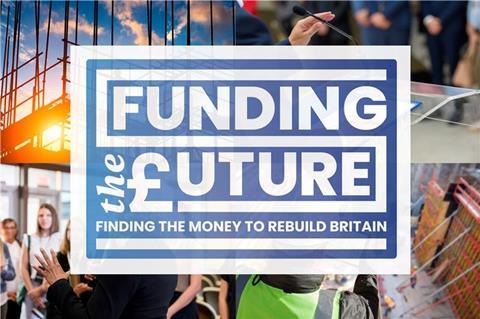The infrastructure strategy has proposed allowing a form of PFI to be used in limited circumstances including healthcare centres for the first time since 2018 вАУ but not yet revealed what the structure will be. Joey Gardiner considers the options

On the first day of the month. the Department of Health and Social Care (DHSC) quietly slipped out a for bidders to come and talk about £1bn of work on the health estate. While the headline figure might already have been enough to get your attention, it was the nature of the procurement that was really startling.
Because this short note kickstarted the first procurement of what is effectively a private finance initiative (PFI) tender process вАУ though you wonвАЩt hear the government call it that вАУ in more than 10 years. The note was looking for market engagement around finding someone to design, build, operate, finance and maintain вАЬprimary and community health infrastructure projects through a public-private partnership (PPP) modelвАЭ вАУ ahead of beginning a formal tender process in June next year.

The tender can be seen as a sure sign that the government is serious about using an updated form of private finance to pay for building new social infrastructure, ahead of a promised final decision on the issue in the autumn Budget.
Last monthвАЩs government infrastructure strategy raised the possibility of using PFI-like models in two cases: neighbourhood healthcare centres and decarbonising the public estate. And some more detail on what this might look like emerged in the , published on July 3. However, nowhere has the government said so far exactly what form the PPP will take вАУ though it has repeatedly talked about вАЬlearning lessonsвАЭ from past experiences.
Here, we examine what can be said about what the model will look like, and what the chances are that the scope of any return to PFI could be expanded further?
Chink of light
The infrastructure strategy gave explicit government support for the use of вАЬpublic-private partnershipsвАЭ to pay for new infrastructure. However, for the most part the strategy limited this government backing to projects where some kind of private income stream exists to ultimately repay the private financing of the project.
This covers all kinds of projects from water company investment in upgraded treatment works and toll roads, to redevelopment of public land to provide a mix of public and private uses.

Of course, while the sector welcomed the official backing for these kinds of projects, of which the fiendishly complex Euston station redevelopment is given as a prime example, the reality is this kind of financing is already allowed вАУ if not always encouraged вАУ anyway. Hence, while the strategy does appear to widen the range of projects likely to be endorsed, some feel this section does not offer much new.
One senior finance figure confesses to вАЬnot thinking much of the [infrastructure] strategyвАЭ for this reason.
>> See also: The infrastructure strategy opens the door to private finance
>> See also: Good luck, 10-year infrastructure strategy. YouвАЩre going to need itвА¶
However, despite its broad focus on non-taxpayer funded PPPs, one short section of the document does reopen the door to the potentially revolutionary idea of PFI-style models. While the government does not use that term to describe them, it appears to be contemplating long-term deals in which private firms design, build, finance, operate and maintain public sector facilities, ultimately paid for by public sector spending вАУ which is what PFI was.
Kevin Hawkins, operations director and head of social infrastructure at PFI specialist developer Kajima, says: вАЬItвАЩs quite exciting, theyвАЩre tentatively reopening the door. It seems pretty positive.вАЭ
According to the strategy, the government will only explore this in вАЬvery limited circumstancesвАЭ. Namely, for certain types of primary and community health infrastructure, and taxpayer-funded public estate decarbonisation projects. The chancellor Rachel Reeves is to make a final decision on whether to push ahead in her autumn Budget. It might not be much, but вАЬitвАЩs the first chink of light weвАЩve had since 2018,вАЭ says Hawkins.
WhatвАЩs the model?
The difficulty for potential investors, contractors and consultants, is that the strategy does not say what exact PPP structure the government will adopt. However, it does refer to the mutual investment model вАУ a form of PFI developed by the Welsh government, as an example of something the UK government will learn from for English projects. The 10-year health plan for England, however, produced by the DHSC is more explicit.
It says the NHS will bring forward plans for a вАЬrollingвАЭ programme of neighbourhood health centres (see panel below), based on the New Labour NHS local improvement finance trust (NHS LIFT) programme which delivered around 350 community health centres in the 2000s. It also, once again, says this will build on the experience of the Welsh MIM.
What is planned for the health estate
While the infrastructure strategy proposed using PPPs for both primary health infrastructure and decarbonisation projects, only in the area of health infrastructure has there been signs of significant progress.
After the Infrastructure Strategy, came the July 1 invitation to market engagement on a ¬£1bn programme of community health infrastructure projects. The tender said the programme will be designed and implemented by the Department of Health and Social Care (DHSC) in conjunction with the National Infrastructure and Service Transformation Authority (Nista), and will involve вАЬthe design, build, finance, operation and maintenance of certain types of primary and community health infrastructure projects through a Public Private Partnership (PPP) modelвАЭ.
While it said the scale of the programme was вАЬindicativeвАЭ and no formal decision on a delivery model had been made, it said it wanted to issue a formal tender by June next year in advance of signing a 30-year contract in June 2027.
Three days later the 10 Year Health Plan for England was issued, in which a major plank was moving the NHS from a model based around care in acute hospitals, to delivery of services in primary care and community settings, with an ambition to establish a Neighbourhood Health Centre in every community across the country.
The plan promised to вАЬprogress rapidlyвАЭ to draw up a business case for private finance in Neighbourhood Health Centres including an assessment of value for money enabling a вАЬfinal decision on the approach [вА¶] by the time of Budget 2025 in the autumn.вАЭ
Both NHS LIFT and MIM are variants of PFI that, unlike classic PFI, include the public sector as partial equity owners in the private sector delivery vehicles that are created to build out the projects (see box below). MIM, which so far has just a few projects under its belt after being developed from 2017 onwards, also sets a variety of social outcomes as specific additional contractual targets for the delivery partner, beyond delivering the facility itself.
Paul Deverill, head of PFI at consultant Ridge, says the lack of clarity on the model is acceptable given that the tendered market engagement can now be used to pin down exactly what the model looks like. вАЬI think, from whatвАЩs been said, the model weвАЩre looking at is a version of MIM and the [Scottish government] hub models,вАЭ he adds.
So, would using a LIFT or MIM-type model mean? Jonathan Barron, senior policy adviser at public healthcare industry member body the NHS Confederation, says LIFTвАЩs shared equity model has been seen as вАЬrelatively successfulвАЭ, while finding private finance for neighbourhood healthcare projects would be a way to free up public capital for other projects.
How MIM and LIFT compare to PFI
NHS local improvement finance trusts (LIFT)
Developed by: UK government/NHS
Usage: Nearly 350 community healthcare facilities with a value of £2.5bn, built by 49 separate LIFT companies, delivered from 2001.
How it differs from PFI: LIFT deals were a form of PFI deal in which the public sector, in the form of Department of Health and Social Care-owned company community health partnerships (CHP), took a 40% stake in the special purpose vehicle undertaking the projects, with CHP ensuring stewardship of buildings in the long-term public interest.
Balance sheet treatment: Would now be classified as on-balance sheet
Mutual investment model (MIM)
Developed by: Welsh government
Usage: Three projects currently under construction: the ¬£1.39bn вАЬHeads of the ValleysвАЭ dualling of the A465; the ¬£312m Velindre Cancer Care Centre in Cardiff; and a programme of up to ¬£500m of education projects across Wales
How it differs from PFI: MIM was developed by the Welsh government to deliver the benefits of PFI while ensuring better social outcomes. It differs from classic PFI by contractually mandating various social outcomes as part of the delivery of the project itself; and giving the public sector an equity stake in the project deliver vehicle.
The structure retains an off-balance sheet classification in part by ensuring the public sector stake is less than 20%
Balance sheet treatment: Off-balance sheet
Kajima Partnerships Ltd is the developer partner for the Velindre Cancer Centre in Cardiff, the ¬£312m project which is one of three major MIM schemes to have so far been contracted. While it is early days for MIM, KajimaвАЩs Hawkins says his experience, 15 months into a 36-month build, has been good so far.
Referring to different PFI structures used in the UK in the past 15 years, Hawkins says: вАЬWeвАЩve worked on PFI, on PF2, on [the Scottish governmentвАЩs] NPD model. To me MIM seems to take the best parts of all of those models.

вАЬYouвАЩve got the public sector investor at the table and that means itвАЩs a true partnership. And then the community value side creates a real focus around that.вАЭ
In other respects вАУ such as contractors working to a fixed-price, fixed-date contract вАУ he says it is structured very similarly to PFI.
However, Jack Banks, partner at PPP consultant P2G, says that if the new model is based on MIM, there are definitely improvements that can be made. вАЬEven if MIM is the template, there should be a desire to look again and learn the lessons, to create something simpler, which is easier to contract.вАЭ
Off balance sheet
The exact structure of the model is likely to be carefully calibrated by the National Infrastructure Service Transformation Authority (NISTA) and the DHSC in order to ensure it retains an off-balance sheet classification. An off-balance sheet rating would mean borrowing would not count against the governmentвАЩs fiscal rules, potentially leaving more headroom to spend on other projects.
The mutual investment model seems to take the best parts of all of those [PFI-type] models
Kevin Hawkins, Kajima
The TreasuryвАЩs director general of public spending, Conrad Smewing, told MPs on the public accounts committee last month that the government was not influenced to go down a PPP route by its balance sheet classification, instead only considering whether вАЬit is better for the taxpayer in the long runвАЭ.
But the reality appears to be something rather different.
Just weeks after SmewingвАЩs comments, the incoming boss of quango NHS England, Jim Mackey, that one of his urgent вАЬ100-dayвАЭ priorities was to вАЬintroduce an off-balance sheet capital investment mechanismвАЭ вАУ the mechanism later referred to in the infrastructure strategy. RidgeвАЩs Deverill says: вАЬDiscussing this with peers, all of the conversations are on the basis that this mechanism will have to remain off-balance sheet to be workable.вАЭ
Zoe Watters, an infrastructure adviser and former PwC partner, says that key to achieving this crucial accounting status вАУ which MIM has but NHS LIFT projects no longer do вАУ will be watching carefully the size of any equity stake offered to the public sector.вАЬWhether itвАЩs counted on government debt is really about how much risk youвАЩve transferred,вАЭ she says.
вАЬSo you can take a public equity stake, and sit on the board, as happens with MIM, as long as that stake is not high. ItвАЩs the level of equity that drives it.вАЭ
In practical terms, she says, any stake of above 20% would tend to create a structure that is hard to justify as being off the governmentвАЩs debt. However, other issues will also need to be carefully considered, such as the potential share of gains from any future re-financing, Watters says.
Again, any public shares of refinancing gains will have to be kept to a low level in order to justify an off-books classification.
Positive
For many, the frustration is simpy that the government is not bolder. While the strategy restricts PFI-like structures to just two types of scheme, NHS EnglandвАЩs Jim Mackey has publicly stated his hope that major acute hospitals вАУ that can now cost anything up to ¬£2bn вАУ could be funded via private finance in future years.
A successful roll-out of these two project types may well open to door to further project types. Why not use a working model that the market and government have got used to?
Carly Caton, partner, Browne Jacobson
Matthew Bevington, policy associate at think-tank the Future Governance Forum, says: вАЬThe health industry has not given up on getting this applied to other sectors and acute hospitals. The NHS Confederation and other NHS bodies will be pushing for this to be applied more widely.
вАЬYou could imagine the government thinking about expanding once this initial market engagement [on the tender] is done.вАЭ
Likewise, Carly Caton, partner at law firm Browne Jacobson, says: вАЬI would say a successful roll-out of these two project types may well open the door to further project types. Why not use a working model that the market and government have got used to and geared up to deliver?вАЭ
However, while the chancellor is expected to confirm the programme of PFI-style investment in neighbourhood health centres at the time of the Budget, commentators donвАЩt think she will immediately expand the scope to other sectors.
Future Governance ForumвАЩs Bevington says: вАЬAt the moment I donвАЩt think sheвАЩll do anything more. This has to play out first вАУ see if thereвАЩs investor demand. If it works, then weвАЩll see.вАЭ

James Stewart, chairman of consultant Agilia Infrastructure Partners, says one of the strategyвАЩs вАЬsweet spotsвАЭ looks to be social infrastructure projects, where the funding is supplemented with additional revenue streams. вАЬIf thereвАЩs a spectrum of projects, with classic RAB [regulated asset base] like the Lower Thames Crossing at one end, to pure social infrastructure [without a revenue stream] at the other end,вАЭ he says, вАЬit feels like this strategy is trying to look somewhere in the middle.
вАЬItвАЩs aiming at PPPs that deliver social value, but perhaps where thereвАЩs a land deal, or car parking charges, or something that can reduce the cost on the taxpayer.вАЭ
From KajimaвАЩs perspective, Hawkins is getting involved in the market engagement and is just excited about the possibility. вАЬWeвАЩre hopeful thereвАЩs a pipeline of work potentially here in two to three yearsвАЩ time,вАЭ he says. вАЬThereвАЩs absolutely the need. WeвАЩre up for a new pipeline.вАЭ

–«њ’іЂ√љвАЩs Funding the Future campaign seeks to examine fresh ways of attracting and using finance to boost construction projects at a time of constrained public finances.
It will examine options for public-private partnerships that can draw on private capital to pay for large infrastructure projects, schools, prisons, hospitals and housing.
It will also look at existing models for private and public funding and examine how these can be optimised to ensure funding is efficiently spent and leads to more shovels in the ground as Keir Starmer looks to construction to boost flagging economic growth.
Over the next few months we will share learning, consult with industry and collect ideas from readers. This will culminate in a special report to be published at our –«њ’іЂ√љ the Future Live Conference in London on 2 October - click here to book your tickets now.
To share your ideas of new funding models, email carl.brown@assemblemediagroup.co.uk. To find the campaign on social media follow #–«њ’іЂ√љfundfuture.























No comments yet